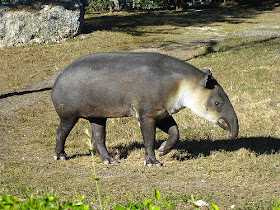 |
| Central American Tapir |
Description and biology
The Central American or Baird’s tapir is a large animal with a medium to dark brown coat. Related to the horse and rhinoceros, it is almost as large as a donkey. An average Central American tapir has a head and body length of 6.5 to 8 feet (2 to 2.4 meters) and weighs between 550 and 660 pounds (250 and 300 kilograms). It stands 36 to 42 inches (91 to 107 centimeters) tall at its shoulder.
The animal has short legs and a stout body that narrows in front, which allows it to move quickly through the forest. A good swimmer, it spends much time in water or in mud. With small, deeply set eyes, the animal has poor vision, but its senses of hearing and smell are acute.
Its nose and upper lip extend to form a short trunk, which the animal uses to shovel food into its mouth. Its diet consists of grass, leaves, and a variety of fruit. Jaguars and mountain lions are the Central American tapir’s main predators.
  |
Male and female Central American tapirs mate at any time during the year. After a gestation (pregnancy) period of 390 to 405 days, a female tapir gives birth to a single calf.
At birth, the calf is covered with protective colored markings that allow it to blend easily into its forest environment. These markings begin to fade within a few months. The calf may remain dependent on its mother for up to a year.
Habitat and current distribution
The Central American tapir is found from southern Mexico to northern Colombia. It lives in a variety of humid habitats, including marshes, mangrove swamps, and tropical rain forests. Biologists (people who study living organisms) estimate the total population of the species to be about 5,000 animals.
History and conservation measures
The Central American tapir once ranged as far south as Ecuador. In the past, the animal was hunted for its meat and hide and for sport. Now legally protected, the tapir nevertheless continues to be the target of poachers.
Despite this problem, the most serious threat to the Central American tapir today is habitat destruction. Over the past four decades, around 70 percent of Central American forest areas have been lost to deforestation.
Vast tracts of land in the tapir’s range have been cleared to create farmland to feed the growing human population in the area. Guerilla warfare within the range presents another threat, particularly because it impedes re search and conservation measures.
For the most part, the Central American tapir is now confined to reserves in Belize, Guatemala, Honduras, Nicaragua, Costa Rica, and Panama.
